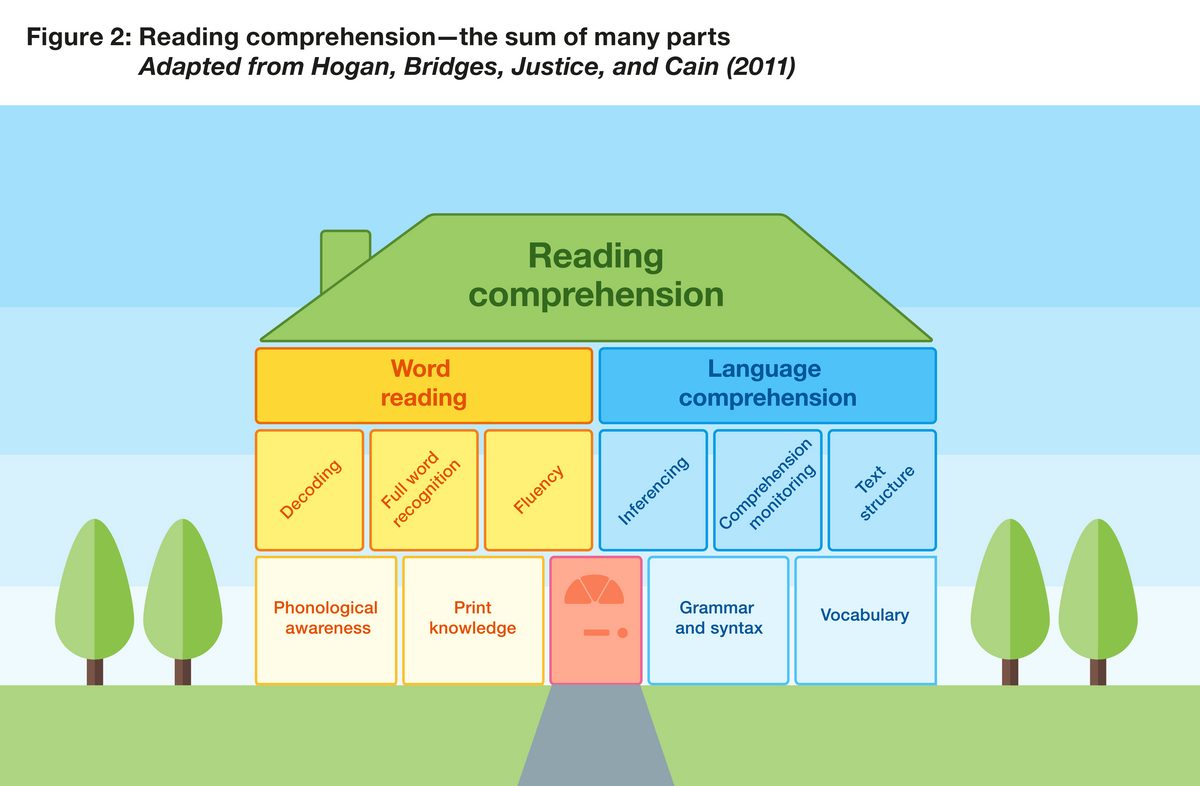Reading is demanding. It is at once dizzyingly complex, requiring us to coordinate several different cognitive processes at once, and an everyday act that feels almost effortless for skilled readers.
It takes extensive teaching and practice for children to learn how to decode letters into sounds and read with fluency. Plus, every teacher knows that just because a child can read a text aloud, there’s no guarantee that they have actually understood it.
To fully grasp a text, children need to know most of the vocabulary it includes, understand grammar and text structures, learn how to connect ideas together as they are reading to make sense of them, infer underlying meanings, and more.
Today, we are publishing the second edition of EEF’s guidance report on Improving Literacy in Key Stage 2.
One of the most exciting additions to the updated guidance report is the ‘reading comprehension house’. It represents a visual summary of the component parts of reading (adapted from Hogan, Bridges, Justice and Cain’s 2011 publication).
The ‘reading house’ is grounded in Gough and Tunmer’s ’simple view of reading’, showing word reading and language comprehension as the two key sides of reading that need to come together to enable reading comprehension (the ultimate goal of reading).

No illustration can perfectly capture how reading works and there is ongoing academic debate about how different aspects of reading relate to one another. And yet, the brilliance of the reading house is that it enables us to make sense of some of this complexity by breaking reading down into key building-blocks.
Understanding the underlying components of reading, how they build on one another, along with how they must come together to enable reading comprehension, is a critical first step for planning effective literacy provision.
And so, what can the reading house tell us about the crucial work of teaching children to read?
The left-hand side of the reading house illustrates that to become proficient at word reading, children need to build an awareness of the sound structures of language (phonological awareness) and knowledge of how language is represented in writing (print knowledge).
This will support pupils to learn how to decode, translating written words into the sounds of spoken language. Over time, learners begin to recognise some full words automatically, after repeated encounters with them, and they learn to read with increasing fluency.
Meanwhile the right-hand side of the house illustrates that to build strong language comprehension skills, pupils need to develop an understanding of grammar and syntax and build up a wide-ranging vocabulary.
They will also need to learn how to make inferences (using information in a text and drawing on their background knowledge to understand things that are implied rather than explicitly stated), learn how to monitor their own comprehension, and learn about different text structures and genres.
As pupils’ word reading and language comprehension improves, their reading comprehension also improves. However, weaknesses in any aspect of the ‘house’ can undermine progress and cause pupils to struggle.
Given this, when a pupil isn’t making the expected progress in reading, a key priority should be to work to accurately identify which specific aspects of reading they are struggling with.
Our guidance report on Improving Literacy in Key Stage 2 provides more detailed discussions on how pupils learn to read and write and summarises the best available evidence on how literacy outcomes in Key Stage 2 can be improved.
A key ambition for this second edition was also to add further exemplification into the report, so the updated version published today now includes tools and examples that will support teachers and school leaders to consider how the guidance can be put into practice.
Our hope is that the reading comprehension house, and other new resources within this second edition of the guidance report, will support teachers and school leaders to think again about their literacy provision and continue to strengthen it over time.

Press Release
EEF publishes updated Key Stage 2 literacy guidance


Blog
EEF blog: Improving Literacy in Key Stage 2

